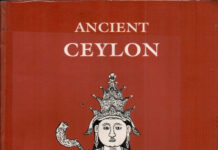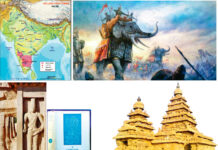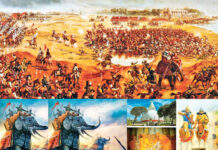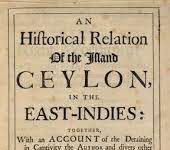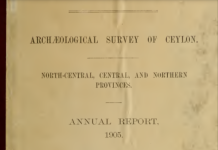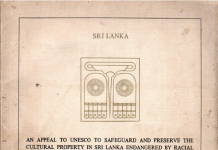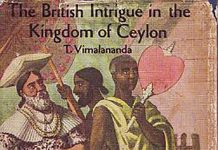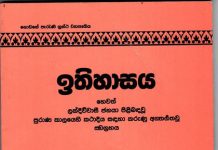Explaining further the situation of Buddhism in South India, Former Joint Director General of the Department of Archaeology, Government of India, T.N. Ramachandran writes in the article, ‘The Great Tamil Buddhists; The History of Buddhism in the Tamil Kingdoms of South India’, about ancient Buddhist cities in South India.
As he explains, according to the Gandhavamsa (The chronicle named Gandhavamsa or Chullagandhavamsa is a volume of a 17th-century Pali literature work by a scholar named Nadapanna. This work of literature describes the post-canonical Pali literature of Myanmar and Sri Lanka), Kancipura, Avanti, and Arimaddana are three great centres of Pali Buddhism. The Buddhist monk Ven. Buddhaghosa Thera in the Nigamana to the Manorathapurani refers to Kanci as a centre of Pali literature. As Ramachandran writes, Ven. Buddhaghosa Thera says in the Papancasudani text that his own writing was at the instance of Buddhamitta when the two lived together at Madhurasutta-pattana (Madura). Again in his Manorathapurani Ven. Buddhaghosa Thera writes that his work was at the instance of Jotipala while the two were living together in Kancipuram and other places in the vicinity.
As Ramachandran explains, to reconstruct the history of South Indian Buddhism we have to depend mainly on the works of the Tamil poets and scholars who were great acharyas (scholars and teachers) who lived from time to time in the areas belonging to the ancient Dravida kingdoms in modern-day South India. Among the most helpful Tamil literature works to reconstruct the history of Buddhism in South India are the Manimekalai, Kundalakesi, Siddhatattogai, Tiruppadikam, Bimbisarakathai, Valaiyapati, and Virasoliyam.
Some of the earliest Tamil Buddhist luminaries of South India are Ilam or the Young Bodhiyar, Aravana Adigal, Sittalai Sattanar, Sanghamitra, Nada-Kutanar, Thera Buddhadatta, Bodhi Dharma, and Dinnaga, says Ramachandran.
Sanghamitra of the Chola kingdom, and king Mahasen of the Sinhala kingdom
A monk named Sanghamitra of the Chola kingdom is mentioned in the Mahavamsa. This monk was an influential monk who interfered with the politics of the Sinhala kingdom, the mastermind behind a great conspiracy that led to political and religious chaos in the country during the 4th century CE. His vicious conspiracies resulted in bloodshed, severe punishments, execution of people, and in the end, even ending up his life.
As Ramachandran explains in his article, Sanghamitra, a Tamil Buddhist monk of the Cola country, who lived in the early half of the 4th century CE., travelled to Anuradhapura in Sri Lanka. He succeeded in converting the Sinhala king to Mahayana (Vaitulya) and being patronised by his second son Prince Mahasena, destroyed the Mahavihara which was a seat of Hinayana, and renewed and enlarged the Abhayagiri Vihara, which became thereafter the stronghold of Mahayana.
Buddhadatta of the Chola kingdom in Anuradhapura
Ramachandran writes about another influential Tamil Buddhist monk of Chola origin. Named Buddhadatta (5th century CE), a Tamil of the Chola country, this monk held charge successively of Buddhist monasteries at Mahavihara in Anuradhapura, Kaveripattinam, Uragapura, Bhutamangalam, and Kanchipuram. In his records, he has written about these monasteries. While staying at Kaveripattinam, Ven. Buddhadatta Thera composed the Buddhavamsatthakatha at the request of his student Ven. Buddha Sikha Thera. Ramachandran further writes that at the request of another disciple, Sumati, Ven. Buddhadatta Thera composed the Abhidhammavatara.
According to Ramachandran, at Bhutamangalam Ven. Buddhadatta Thera stayed in a Buddhist monastery built by a Vaisnava, Kannadasa alias Venu (Vinhu) das, and completed another work called Vinaya-viniscaya. His disciple, Ven. Buddha Sikha Thera followed him everywhere.
On one occasion, Ven. Buddhadatta Thera was invited to visit Sri Lanka. While his stay in Sri Lanka he compiled other works at the request of a Sinhala Mahathera or chief monk Ven. Sankhapala Thera. These works are known as Uttaravinicchaya, Ruparupa-vibhaga, Jinalankara, and a commentary on Buddhavamsa called Madhuratha-Vilasini. During Ven. Buddhadatta Thera’s stay in Sri Lanka, he met the famous Ven. Buddhaghosa Thera there and the two had friendly discourse.
While the Gupta king of this time in the Gupta Empire of India, King Kumara Gupta, was a patron of Ven. Buddhaghosa Thera, Ven. Buddhadatta Thera’s patron was the Kalabhra king Accyutavikkanta (Acyuta Narayana) of the Colanadu. The Kalabra Empire was a Buddhist empire that rose to power in South India before the Dravida kingdoms rose to the height of their power.
Ramachandran writes that the Buddhist text Gandhavamsa mentions 10 South Indian Buddhist teachers who composed literature works and speaks also of 20 other Buddhist teachers of South India who wrote books in Pali at Kanchipuram.
The ten South Indian Tamil Buddhist teachers are;
1. Buddhadatta (5th century CE).
2. Ananda, the author of Mulatika on the Abhidhammattakatha.
3. Dhammapala (5 – 6th century CE) a native of Tambarattha (Tirunelveli District), who became successively the head of the Buddhist monastery called Bhataraditta Vihara at Kanchipuram and the Mahavihara at Anuradhapura, wrote commentaries on Buddhist basic texts, such as Attakatha, Paramartha Manjusa, and Nettipakaranatthakatha. He resided in the city of Tanjai in the Tirunelveli District.
4-5. Two unnamed former teachers (Purvacaryas) who wrote the Niruttimanjusa and Mahaniruttisankhepa.
6. Mahavajirabuddhi, author of Vinayaganthi, a glossary of the five Vinaya books.
7. Cullavajirabuddhi, the names of his work are not traceable.
8. Dipankara Thera alias Buddhapriya Thera and Coliya Dipankara, was a disciple in Sri Lanka of Ananda Vanaradana, and later on, became the head at Kancipura of Baladicca Vihara. He was the author of the Pali works, Vajjamadu and Rupa Siddhi, the former on Buddhist art, and the latter on arithmetic. He also wrote a commentary on the Rupa Siddhi. He wrote a tika on Sampapancasatti also.
9. Culladhammapala who wrote the Saccasankhepa.
10. Kassapa, who wrote the Mohaviccedani and Vimativicccedana.
Ramachandra reveals that South India continued to be a powerful centre of Pali Buddhism and Pali Buddhist literature as late as the 12th century CE. According to studies, Dravida Buddhist monks were traveling in Sri Lanka during the time from the Anuradhapura Kingdom to the 13th century CE, and were influential monks who had spread their powers into the country’s religion and politics.
Ramachandran identifies the names of more Tamil Buddhist scholars through his studies. From the Talaing records of Kalyani, we get a list of Buddhist acharyas (scholars/ teachers) of South India.
They are as follows;
Kaccayana, author of the first Pali grammar.
Buddhavira, author of the Sutta-sangaha.
Nana or Nanagambhira, the author of Tathagatotpatt.
Anuruddha (12th century CE) of the Pandya land who became popular in
Sri Lanka and Burma via his works; Abhidhammathasangaha, Paramattha-vinicchaya, and Nama-rupapariccheda.
Ven. Dharmakirti Thera of the Pandya country in the Dambadeniya Kingdom.
Ven. Dharmakirti Thera (13th century CE) of the Pandya country was another celebrated Buddhist teacher who was invited and patronised by the Sinhala king, King Parakramabahu II (1236 – 1268) of the Dambadeniya Kingdom. The influential thera organised in Sri Lanka an international conference of Buddhists. The Dathavamsa (the story of the sacred Tooth Relic) and Culavamsa (the latter part of Mahavamsa recording the history of Sri Lanka from Mahasena to Parakramabahu II) are works that are ascribed to this Ven. Dharmakirti Thera.
Ramachandran writes in his scholarly article that, “The Buddhist monks formed a galaxy of stars that illumined the Buddhist firmament in South India for nearly 1,300 years.”
Buddhism in South India beyond 7th century
However, some scholars say that Buddhism lost its grounds in South India after the 7th, and 8th centuries and gradually started to decline. Yet, some archaeological remains such as Buddha statues and ruins of Buddhist monasteries, and kovils where Buddhist remains lie beneath, narrate the story of Buddhism’s existence in South India beyond the 8th century CE. The decline of Buddhism in South India was due to the rise of the more organised Hindu religion, Ajivakism, and Jainism. Especially the Bhakti Movement in South India was a deathblow to Buddhism in South India. During these dark times in the history of Buddhism in South India, many of the Dravidian Buddhist monks and followers, fled to Sri Lanka to escape execution and harsh treatment. The vice-versa happened centuries before. During the Anuradhapura Period, in times of war, famine, and civil unrest, Sinhala monks fled to South India as it was a safe, welcoming, and comforting place for them.
Even today, although desperate efforts had been taken to eradicate Buddhism from the land of South India, there remain followers of the faith, and a number of Buddhist temples still flourish in the area. While most of these are modern temples, archaeological evidence such as ruins of Buddhist monasteries and a notable number of Buddha statues are evidence of the spread of Buddhism in South India. There had been found Buddha statues in Sri Lanka that belong to the medieval time of Sri Lanka that was imported to Sri Lanka from Tamil country. These pieces of evidence reveal the strong cultural and religious links between the ancient Sinhala and Dravidian kingdoms.
The influence of Cambodian and Javanese Buddhist kingdoms on the Dravidian land also had a major role to play in the development of Buddhism in South India.
In our next segment, we shall explore a few pieces of archaeological evidence such as Buddha statues, ruins of Buddhist monasteries, and stupas in South India. What we can understand through these archaeological pieces of evidence is that, during historical times, there had been a strong cultural, religious, and political bond between the Dravidian kingdoms and the Sinhala kingdom. There had been animosities between the two, yet they were mere political rivalries that rose to power from time to time. Kings of both lands attempted to expand their political power and challenged each other, but this has not been happening continuously. Studying the histories of the Sinhala and Dravidian kingdoms what we clearly see is s close-knit and friendlier cultural and religious bond the two lands shared. Also, during times of despair and political unrest, monks, scholars, kings, and princes found comfort and security in each other’s countries. Sinhala and Dravidian kings both had hidden their ‘Raja-Kakudha-Bhanda’ in each other’s countries to keep them safe from enemies. Also, marriages had been strengthening the cultural and political bonds between the two lands.
Until the rise of a rather extremist form of religious movements that had no understanding in religious harmony, religious and cultural tolerance, and respecting other religions, and until the rise of the Western powers in the region including South India and Sri Lanka, peace was undisturbed between the Sinhala and Dravidian cultures.
To be continued…
(Information courtesy; The Mahavamsa, A Concise History of Ceylon by Prof. Senerath Paranavitana and C.W. Nicholas, Buddhist Remains of South India by Dr. D. Dayalan, The Great Tamil Buddhists; The History of Buddhism in the Tamil Kingdoms of South India
By T. N. Ramachandran)
By Ama H. Vanniarachchy

